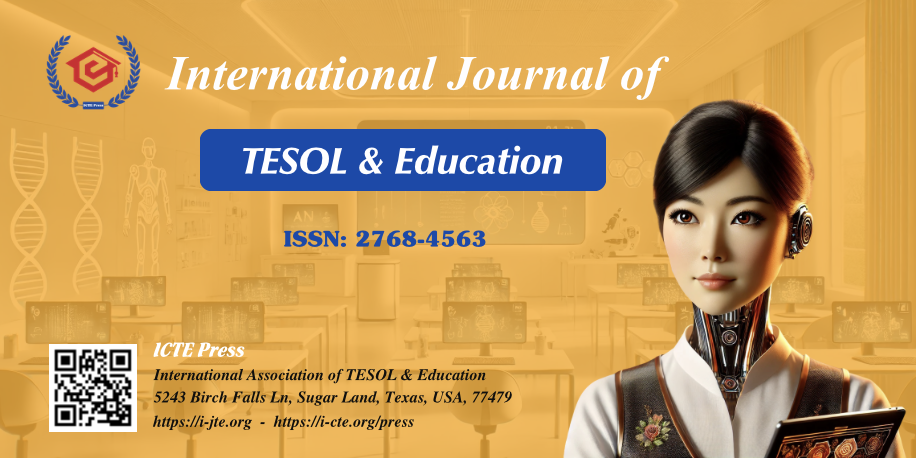An Investigation into the Phenomenon of Morphological Conversion in Current Textbooks of English and Vietnamese Literature for High Schools
DOI:
https://doi.org/10.54855/ijte.22238Keywords:
Conversion, teaching, English, Vietnamese, LiteratureAbstract
Conversion is a common phenomenon in both languages which are English and Vietnamese, especially in terms of morphology. The study investigates the phenomenon of morphological conversion in current English and Vietnamese Literature textbooks for High schools. Based on those survey results, the authors analyzed the similarities and differences of this phenomenon between the two disciplines to propose appropriate teaching methods when encountering it in the teaching process. The research used the inductive method to synthesize theories from available data about the phenomenon of conversion and the survey approach to analyze the conversion phenomenon density in the English and Vietnamese Literature books statistically at the high school level. Finally, the comparative method was used to point out the similarities and differences between the above phenomena in the textbooks of the two subjects. From the collected data, this study showed that the phenomenon of conversion in the textbooks of English and Literature has occurred. Through the research paper, the authors would like to give some notes and suggestions on appropriate teaching methods for high school teachers when encountering this phenomenon in the teaching process.
References
Adams, V. (1973). An introduction to modern English word-formation. London: Longman.
Akmajian, A., Demers, R. A., Farmer, A. K., & Harnish, R. M. (2001). Linguistics: An introduction to language and communication (5th ed.). Cambridge, Massachusetts: MIT Press.
Al-Murib, Z. A. F (2021). Conversion in English. Education and Linguistics Research, 7(1), 54-61. https://doi.org/10.5296/elr.v7i1.18624
Andini, S., & Pratiwi, L. (2013). Analysis of Derivational Affixes of Fuadi’s Five Towers Novel and Its Contribution for Grammar Meaning Discourse. ETERNAL (English Teaching Journal), 4(1). doi:10.26877/eternal.v4i1.1944.
Dao, T. L., Nguyen, H. D., & Tran, T. D. (1998). Co so tieng Viet. Hanoi: Vietnam Education Publishing House.
Diasti, K. S., & Bram, B. (2020). Investigating students’ familiarity with conversion, an English word formation process. Elt Echo: The Journal of English Language Teaching in Foreign Language Context, 5(1), 14-21.
Diep, Q. B. (1998). Ngu phap tieng Viet (tap 1). Hanoi: Vietnam Education Publishing House.
Fernández, M. (2001). On the Status of Conversion in Present-Day American English: Controversial Issues and Corpus-Based Study. Atlantis, 23(2), 7-29.
Gadimova, L. S. (2021). The Cognitive Bases of Conversion in Modern English. Theory and Practice in Language Studies, 11(3), 308-313.
Ginzburg, R. S., Khidekel, S. S., Knyazeva, G. Y., & Sankin, A. A. (2004). A course in modern English lexicology (2nd ed.). Higher School Publishing House.
Girunyan, G. (2009). English Lexicology (Theoretical Course). Yerevan: Gasprint.
Ho, L. (1976). Van de cau tao tu tieng Viet hien dai. Hanoi: Social Sciences Publishing House.
Hoang, V. H., Ha, Q. N., & Nguyen, V. K. (1998). Tu tieng Viet (hinh thai – cau truc – tu lay – tu ghep – chuyen loai). Hanoi: Social Sciences Publishing House.
Kiparsky, P. (1982). From Cyclic Phonology to Lexical Phonology. In H. van der Hulst and N. Smith, eds., The Structure of Phonological Representations, Part II, 131-175. Dordrecht: Foris Publications.
Le, C., & Phan, T. (1983). Giao trinh ngu phap tieng Viet (tap 1). Hanoi: Vietnam Education Publishing House.
Lee, Y. (2009). Conversion as zero affixation: Evidence from affix interaction. Korean Journal of English Language and Linguistics, 9(1), 135-160.
Nguyen, K. T. (1997). Nghien cuu ngu phap tieng Viet. Hanoi: Vietnam Education Publishing House.
Nguyen, V. Tu. (1978). Tu va von tu tieng Viet hien dai (1st ed.). Hanoi: Dai hoc va Trung hoc Chuyen nghiep Publishing House.
Plag, I. (2003). Word-Formation in English (Cambridge Textbooks in Linguistics). Cambridge: Cambridge University Press. doi:10.1017/CBO9780511841323.
Quirk, R., Greenbaum, S., Leech, G., & Svartvik, J. (1972). A Grammar of Contemporary English. London: Longman.
Sweet, H. (1900). A New English Grammar, Logical and Historical: Part I: Introduction, Phonology and Accidence. Oxford: Clarendon Press.
Štekauer, P., & Lieber, R. (Eds.) (2005). Handbook of Word-formation (Vol. 64). Dordrecht: Springer.
Tran, H. A., & Dang, T. H. (2014). Chuyen loai cua tu trong tieng Viet. Retrieved from https://tckh.tvu.edu.vn/sites/default/files/magazine-pdfs/tapchiso15_pdf_12.pdf
Vo, T. N. A. (2013). Tong quan ve hien tuong chuyen loai trong tieng Viet va tieng Anh. Tuyen tap Viet Nam hoc, 7-25. Ho Chi Minh City: National University Publishing House.
Yule, G. (2014). The Study of Language (5th ed.). USA: Cambridge University Press.
Downloads
Published
Issue
Section
License
Copyright (c) 2022 Pham Thanh Hoai, Nguyen Xuan Minh Hai

This work is licensed under a Creative Commons Attribution 4.0 International License.
The copyright of all articles published in the International Journal of TESOL & Education (ijte) remains with the Authors, i.e. Authors retain full ownership of their article. Permitted third-party reuse of the open access articles is defined by the applicable Creative Commons (CC) end-user license which is accepted by the Authors upon submission of their paper. All articles in the ijte are published under the CC BY-NC 4.0 license, meaning that end users can freely share an article (i.e. copy and redistribute the material in any medium or format) and adapt it (i.e. remix, transform and build upon the material) on the condition that proper attribution is given (i.e. appropriate credit, a link to the applicable license and an indication if any changes were made; all in such a way that does not suggest that the licensor endorses the user or the use) and the material is only used for non-commercial purposes.
Authors retain copyright and grant the journal the right of first publication with the work simultaneously licensed under a Creative Commons Attribution 4.0 International License that allows others to share the work with an acknowledgment of the work's authorship and initial publication in this journal.
Authors are able to enter into separate, additional contractual arrangements for the non-exclusive distribution of the journal's published version of the work (e.g., post it to an institutional repository, in a journal or publish it in a book), with an acknowledgment of its initial publication in this journal.











